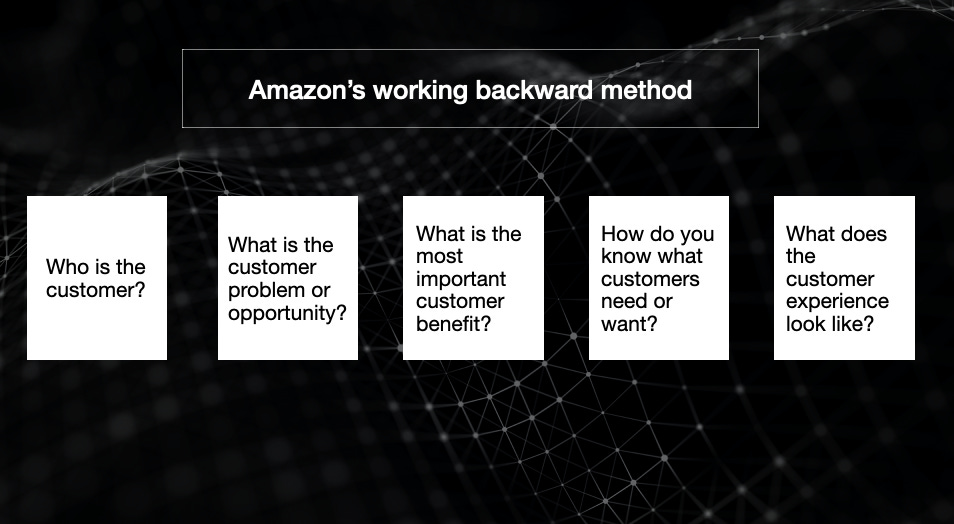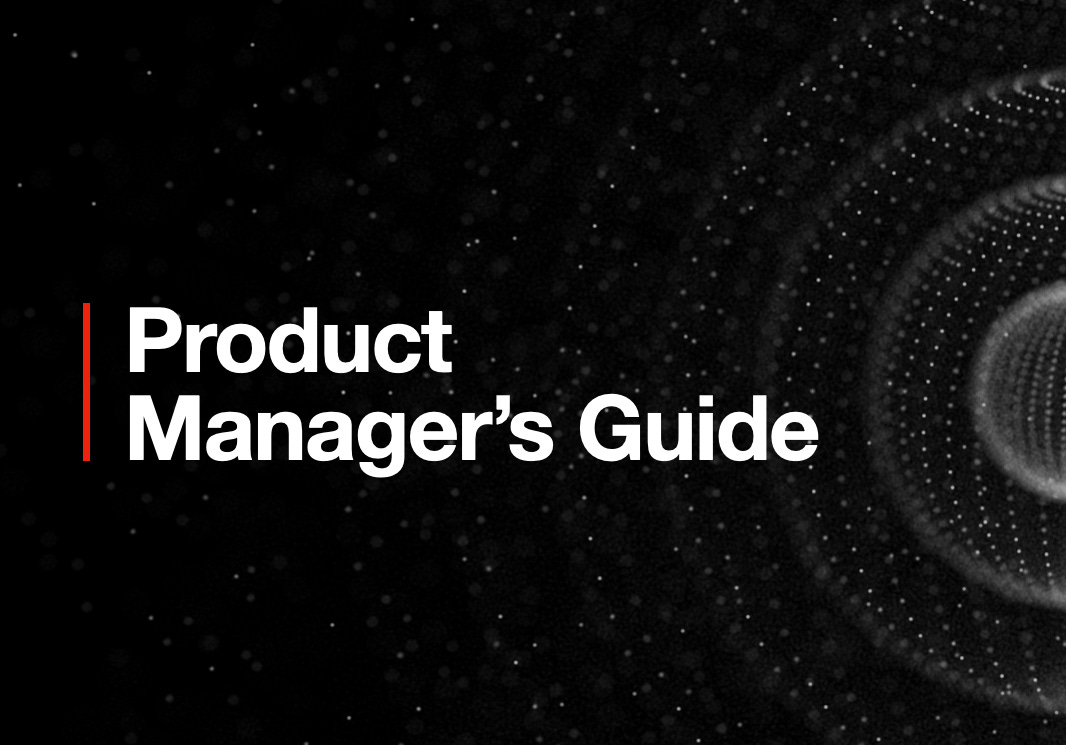Product Framework: Working backward
Great products and services come from deeply understanding customers.
What Is the Working Backwards Framework?
The Amazon working backward method is a product development approach that starts with the team imagining the product is ready to ship.
The product team’s first step is to draft a press release announcing the product’s availability. The audience for this press release is the product’s customer.
Why Should a Product Team Use the Working Backwards Method?
As Amazon’s product management teams have explained over time, they find several benefits of using the working backward method.
It’s a useful gut-check about a product’s viability.
Drafting a press release is a lot easier and requires far fewer resources than building a minimum viable product or even creating and sending out a series of customer surveys.
When a product team writes this mock press announcement, they can get a gut-check about whether they’re enthusiastic enough about the product to pursue the idea further. If they find themselves uninspired by the draft, that is a good indicator the product idea lacks something or that the team has not fully thought through the problems or the solution.
The press release can become a useful guide during development.
If the team decides an idea is worth pursuing after this exercise, then they can use the press release as a strategic guide as they move into development. The press announcement can serve a similar function as the product roadmap. It can help keep the team on track and aligned around the big ideas and plans for the product.
It supports the principle of customer centrism.
One of Amazon’s guiding principles is what the company calls customer obsession. Amazon’s strategy is to start with a focus on the customer, and then figure out what products to build to delight that customer.
Using the working backward method fits perfectly with Amazon’s customer-centric approach. The product team needs to think through all of the reasons it built the hypothetical product, so it can draft a compelling news release to announce the product’s release in a way that would convince the target customer to run out and buy it.
Unless the product team has been customer-obsessed in writing the press announcement, that document won’t make a case for them actually to build the product.
Working Backwards At Amazon
Working Backwards At Amazon, we start with the customer and work backwards. Begin the Working Backwards process by answering the 5 Customer Questions. Answering these questions at the start of your project will help you apply a customer-centric focus and guide your thinking as you invent new customer experiences.
5 Customer Questions
1. Who is the customer?
2. What is the customer problem or opportunity?
3. What is the most important customer benefit?
4. How do you know what customers need or want?
5. What does the customer experience look like?
1. Who is the customer?
Start the Working Backwards process by establishing an understanding of who your customer is and what their needs are. At Amazon, we create products and services for many types of customers. Some examples include:
• IT Admins and software engineers using AWS services
• Readers using their Kindles
• Prime members watching original content from Amazon Studios
• Entrepreneurs and small businesses that sell on Amazon
2. What is the customer problem or opportunity?
Now that you’ve identified a customer type and their needs, the next step is to describe current problems or new opportunities. What challenges does your customer wrestle with? What could be improved?
3. What is the most important customer benefit?
While you may have eight breakthrough ideas or game-changing solutions, you won’t have the resources to build all of them. This question forces focus – challenging you to prioritize, select, and define a specific solution.
4. How do you know what customers need or want?
Customer data comes in many forms. Ask yourself, what are the best signals to inform the customer experience?
• Behavioral metrics are quantitative measures of what customers are doing with current products or experiences, which you can measure at scale or collect through direct observation.
• Qualitative feedback includes verbal feedback from customers, which is critical to understanding why a customer does what they do, as well as qualitative observations of what they are doing and how they are doing it.
• Subjective metrics are quantitative measures of the subjective customer experience that can be assessed with any closed-ended rating scales or existing standardized instruments.
5. What does the customer experience look like?
Sketching is a fast and frugal way to communicate the end-to-end customer experience. Everyone can do it.
Here's an example outline for the press release:
Heading - Name the product in a way the reader (i.e. your target customers) will understand.
Sub-Heading - Describe who the market for the product is and what benefit they get. One sentence only underneath the title.
Summary - Give a summary of the product and the benefit. Assume the reader will not read anything else so make this paragraph good.
Problem - Describe the problem your product solves.
Solution - Describe how your product elegantly solves the problem.
Quote from You - A quote from a spokesperson in your company.
How to Get Started - Describe how easy it is to get started.
Customer Quote - Provide a quote from a hypothetical customer that describes how they experienced the benefit.
Closing and Call to Action - Wrap it up and give pointers where the reader should go next.
Here’s a mock press release to show you how it all comes together:
CIRCULERT APP ALERTS SHOPPERS WHEN THE PRODUCTS AND SERVICES
THEY WANT BECOME AVAILABLE OR DROP IN PRICE
If a product or service isn’t available today or at the right price, Circulert helps shoppers buy it later, for less.
SEATTLE–January 1, 2021 - Circulert, a Seattle company, today launched a new application for iOS and Android that notifies users when the products and services they want or need become available for sale or drop in price.
Many items consumers want to buy aren’t available today, or the price might not be quite sharp enough to prompt a purchase. If there’s a specific brand of clothing you like, you have to keep checking retailer websites so see if they’ve released a new line, or spend time looking through a slew of daily emails from every retailer you’ve ever shopped from to find the one email that tells you about new products you care about. How often have you found out that your favorite band is playing a show in your town after all the tickets are sold out? How often have you picked through “web specials” of your favorite clothing line when they go on discount, only to find that the only sizes still available of that one product you love are XXL of XXS? Too often.
Circulert solves these problems by telling you when you can buy the things you want, or buy the things you want at the price you want. No more work. No more missing out. Circulert learns about the products and services you care most about, and then sends you only the notifications you want. You can choose the notification style or frequency, or view a feed of recent alerts. You are in control. At launch, Circulert can send you availability or price drop notifications for products like clothing, music, or books from your favorite brands, artists or authors. Circulert can also tell you when your favorite band schedules a show in your town, when a flight between you and your long-distance partner is a screaming deal, or when the price of that sweet new tech bauble drops below the amount your spouse is likely to notice on the credit card statement.
“Our goal with Circulert is to take the hassle out of buying things later,” said Ian McAllister, creator of Circulert. “There are tens of thousands of retailers on the web selling everything imaginable. Circulert helps consumers filter out the noise and all the stuff they don’t need, and helps them get the things they do need at the best price, saving them time and money.”
To try out Circulert, go to Circulert.com and download the app for iOS or Android. Connect the app to your Amazon, Ticketmaster, and other online accounts, and then review the suggested alerts. Circulert will then send you only highly relevant notifications when the items you want are available at the right price. You can star items that you want to get back to easily, share them with friends and family, or follow through and buy them.
“I absolutely hate missing out on a great deal,” said Clare Keating, a nurse in Seattle. ”To make sure I don’t miss out I used to have to hit my favorite websites every few days. With Circulert, I found out about great deals right away and never miss out.”
If you want to save time or money (or both!), visit circulert.com today.
# # #



